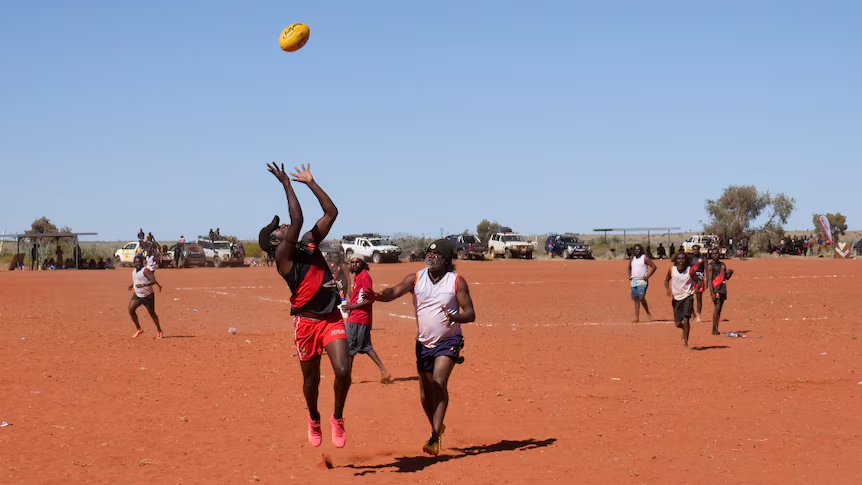According to historians the roots of Australian Football League (AFL) can be traced back to the First Australians/Indigenous Australians game of Marn Grook.
According to the AFL’s web page on history of the AFL here History of Football – AFL.com.au
The history starts from 1858. Or at least that’s what they want to talk about the game since that date.
And to quote on their history page “In 2008 the AFL published The Australian Game of Football Since 1858” It’s a very odd and awkward way to start discussing the history of the sport and this no doubt points to their dis-ease with the topic. As it states “Since 1858” this implies that there was a history prior to 1858. Which they have chosen not to mention.
It’s one thing to disregard and disrespect something however, to remove it from the history of what it is that this organisation is meant to represent is more akin to a crime.
In 2023 the AFL organisation reported a revenue of $1 Billion (1,063,547,000 ). In the AFL annual report they list various expenses such as payments to clubs, payments to AFLPA totally close to $500m and then $89m in 2023 for Game Development.
What is not listed on the books are royalty payments to the origination of the sport, to the indigenous game Marn Grook. Marn Grook is a Gunditjmara word for ‘game ball’. It was well known and a popular game for the indigenous people around the time of early colonisation. A white person Tom Wills was at one point credited with being the originator of AFL and he happened to live in Moyston, an area where Marn Grook was commonly played.
Since it seems that Marn Grook is becoming more referenced in history rather than Tom Wills, unless you read the AFL website which avoids the whole topic.
More information on Marn Grook here: https://yoorrookjusticecommission.org.au/news-stories/marngrook-celebrating-the-origins-of-afl/
Royalty payments exist within the mining industry.
I know them quite well as my Dad was in the mining industry.
How it typically works is when someone was not the originator of a mining tenement then quite often royalties can exist on tenements where someone else has done work before. This can make a huge difference.
It can be the equivalent of saying “Hey there is gold/iron ore/any mineral here”, it can often come with data to support this with things like “we have drilled 20 holes to a depth of X and there are mineralisations of these levels at these depths”. This information is crucial to the new comer investing money into this operation and ultimately creating a successful productive mine.
Australia’s richest person, Gina Rinehart’s wealth was built on the back of a 2.5% royalty that her father Lang Hancock established in 1963. This meant that a mining company would explore and develop the tenement area that Hancock had and would pay Hancock this small percentage of royalty on earnings. This small percentage ended up being a massive amount of money in the long term as the mine was so successful.
While it could be easy for someone to quickly dismiss royalty payments as something valid and fair when seeing how grossly rich it can make some. It’s important to remember that Gina Rinehart and Lang Hancock is an unusually lucrative situation.
There are more ethics to royalty payments than extreme wealth.
Royalty payments are a way of looking at compensating or simply paying for value.
Lang Hancock didn’t have the money to invest to develop the mine himself and the mining company also didn’t have to pay Lang a large amount up front. A royalty payment worked well in this instance.
Another way to look at it is if you were to lease an empty shop front it might cost $500 per week.

If that shop front also had a profitable business in it that someone developed then you would expect to pay much more for this as someone has put time into developing it and you would benefit from the income it generates. If there was a longer term payment arrangement, this would be similar to a royalty.

Royalties can be mutually beneficial too, as the miner will only pay money to the royalty if they are fortunate enough to make the money. And it is an agreement that both the miner and tenement holder agree to in the beginning of the transaction so it is a fair transaction.
The AFL don’t appear to pay any royalties and even respect to it’s indigenous roots.
Some historians deny a connection of AFL originating from Marn Grook and reference it as anecdotal and no clear proof. However it seems their speculation of it not being connected is no less anecdotal.
Undeniably, Australian Rules Football was a new creation of a game in Australia, it was not brought from the mother country. It’s clear that the game did originate in Australia and it’s clear that Marn Grook did exist in Australia during this time. It does point to common sense to conclude that there is a connection there.
The AFL team of the Sydney Swans may do more to recognise Marn Grook as an important part of the game’s heritage. Respect to them.
As can be seen in this video:
Is it coincidental that there are so many brilliant indigenious AFL players? Is it a coincidence that AFL/Marn Grook is something that they have a love for in their communities? It’s in their genes, in their epigenetics, it’s in their heritage.

The AFL’s inability to acknowledge Marn Grook at all says more about their social irresponsibility and lack of ethics.
Or perhaps it is in fear of royalty payments. If they can afford to spend $89 per year on game development. What about a royalty payment of 2.5% ($20m) in game heritage, this would be in genuinely developing the game as a decent authentic organisation. The $20m can be used to recognise the importance of the origination of Marn Grook, it could be used to contribute to indigenous health, sports and well being so there can be many more brilliant indigenous players.
Royalty payments are fundamental to our ability to recognise that someone has put work into something for which we intend to prosper. There are laws to facilitate this important fair arrangements.
If the AFL has trouble understanding royalty payments then I am sure they will have no problems if AFL games are streamed and broadcast for free on multiple platforms for which they receive no payment or acknowledgement.